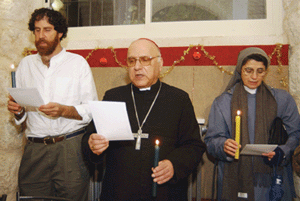When he resorts to civil disobedience, his long body hugging the earth of a Palestinian olive orchard or a home slated for demolition, Rabbi Arik Ascherman sets loose upon the Holy Land the ghost of the Rev. Dr. Martin Luther King Jr. Like King, Ascherman lets the prophets’ hard-bitten calls for justice speak through his resisting body.
Rabbi Ascherman’s humanitarian Judaism, a gift from his parents in Erie, Pa., has saddled the executive director of Rabbis for Human Rights with many arrests, death threats and a long trial in a Jerusalem court. Lecturing once in a Manhattan synagogue, the Reform rabbi mentioned: “My big shock when I came to Israel [in 1994, at age 32] was discovering that the values I grew up with were not necessarily shared by many Israelis.” At least these values did not seem to be shared by religious Israelis. On the other hand, the Israelis who refuse to do military service in the occupied territories of Palestine, who protest the occupation and its abuses, are overwhelmingly secular Jews.
Rabbi Ascherman, arriving in a war-torn, bitterly polarized country, harbored no illusions that things would be easy. When Rabbis for Human Rights was founded in Israel in 1988, it was in response to what some perceived as the moral slumber of the rabbinical community concerning the abuses suffered by Palestinians in the occupied territories. “The religious community,” Rabbi Ascherman said, “has been socialized into a very dangerous mixture of extreme nationalism and extreme particularism.” The activist rabbis were usually activists on the right; that is to say, they were supporters of the settler movement.
Rabbi Ascherman, whose conscience and passion catapults him across the Green Line to aid Palestinians menaced by Israeli bulldozers, nonetheless can examine the conflict with Talmudic objectivity. “When we get back to peace negotiations, there will be the same majority of Israelis and Palestinians who favor a bilateral peace agreement. There will also be a majority of Palestinians who, as the polls show, favor some level of violence in the belief that such threats are necessary to maintain Israel’s interest in the peace process. Palestinians will have to learn that violence does not promote, but destroys that process. Israelis must learn that there is no equality, no symmetry here. We are the dominant economic and military power. We control what happens on the ground in the occupied territories. You cannot negotiate peace on the one hand and violate human rights on the other.”
A particularly neuralgic issue is the demolition of Palestinian homes that lack legal permits. In Rabbi Ascherman’s words, “If you are a Palestinian living in East Jerusalem or in the West Bank, you can have a clean security record and title to your land. But in most cases, unless you pay a bribe or agree to be an informer, you cannot get a legal building permit. As a result, there are many people living in houses that are illegal, and then thousands of them are made homeless by demolition orders.”
At a recent Rabbis for Human Rights conference in New York City, Rabbi Ascherman learned that one of the homes he had tried to save from the bulldozer without success, a home that had been rebuilt with financial contributions from rabbis like himself, was bulldozed a second time. Within hours, the rabbis attending the conference had raised the money necessary to rebuild the house. But for Rabbi Ascherman, this was not enough. He said:
We have launched a court appeal challenging this policy. Even at my trial, which attempted to put this policy on trial, the judge was able to avoid the issue. All he was interested in was did you, or did you not, stand in front of the bulldozer. Now, that same judge has demanded that the municipality explain how it can manipulate building and zoning laws to make it impossible for someone to build legally. In the judge’s words, “Putting a stumbling block before the blind” is how the Jewish tradition puts it. This is what you do when you make it impossible for the Palestinians to succeed, and then destroy their homes.
In January 2004, Rabbi Ascherman was put on trial in Israel for his human shield activities in front of Palestinian homes in Isawiyah and Beit Hanina in March and April of the previous year. Why he was tried then for doing what he had been doing for years still mystifies him. Perhaps the Israeli establishment’s patience with him had finally been exhausted. Or perhaps it was a question of the tactics he chose: he went limp and made the police drag him away, not only when he was arrested but also later at the police station, which infuriated the arresting officers. “Back there, you did it for the cameras. But why are doing it here?”
In any case, the rabbi made the most of his ordeal. At one point, he reminded the court that the trial had opened at the time of the death and birth anniversaries of the great rabbi Abraham Joshua Heschel. “He often said that ‘in a democracy a few are guilty but all are responsible.’ I am very deeply affected when the Torah, which I am sworn as a rabbi to uphold, is being trampled on. In a piece which I wrote immediately after the demolition of the Da’ari home (in Isawiyah), I noted that my kippah was lost in the rubble. I wondered whether this symbolized what was being done to Jewish values and whether someday the kippah would be found as a reminder that someone had stood against this evil in the name of Torah.”








